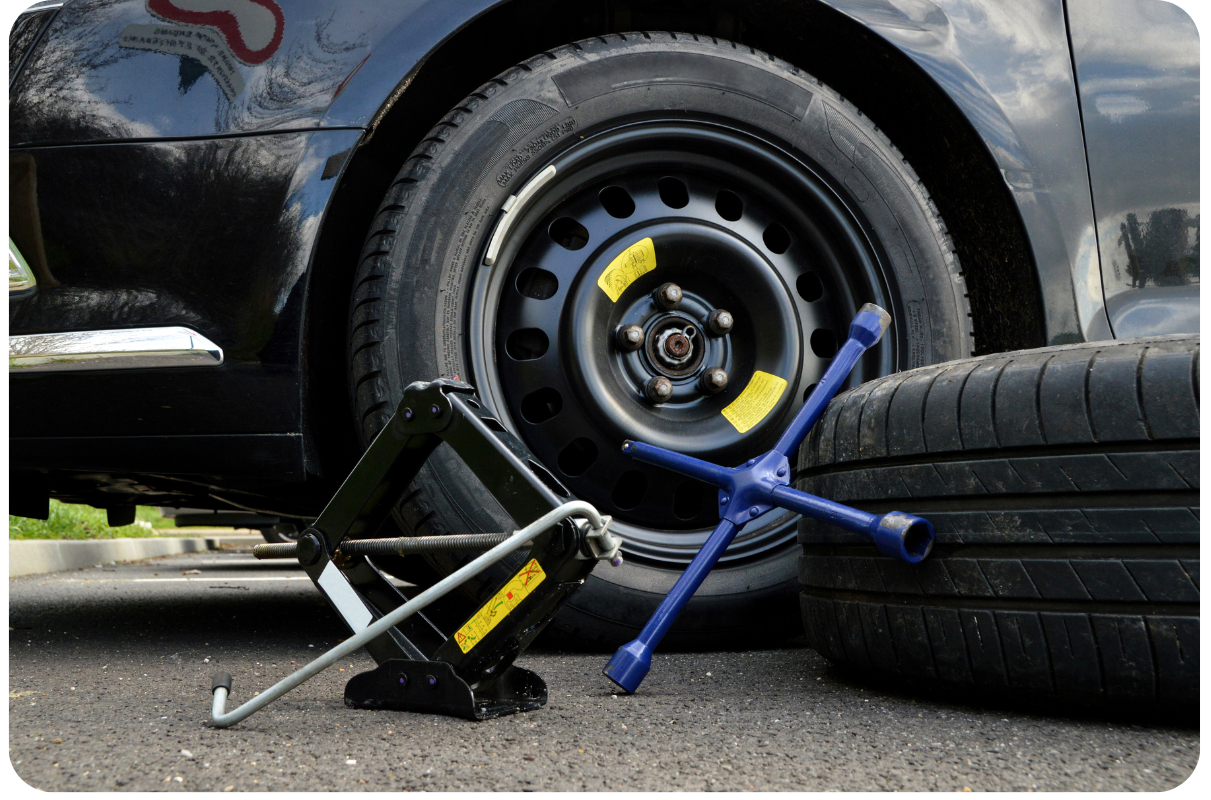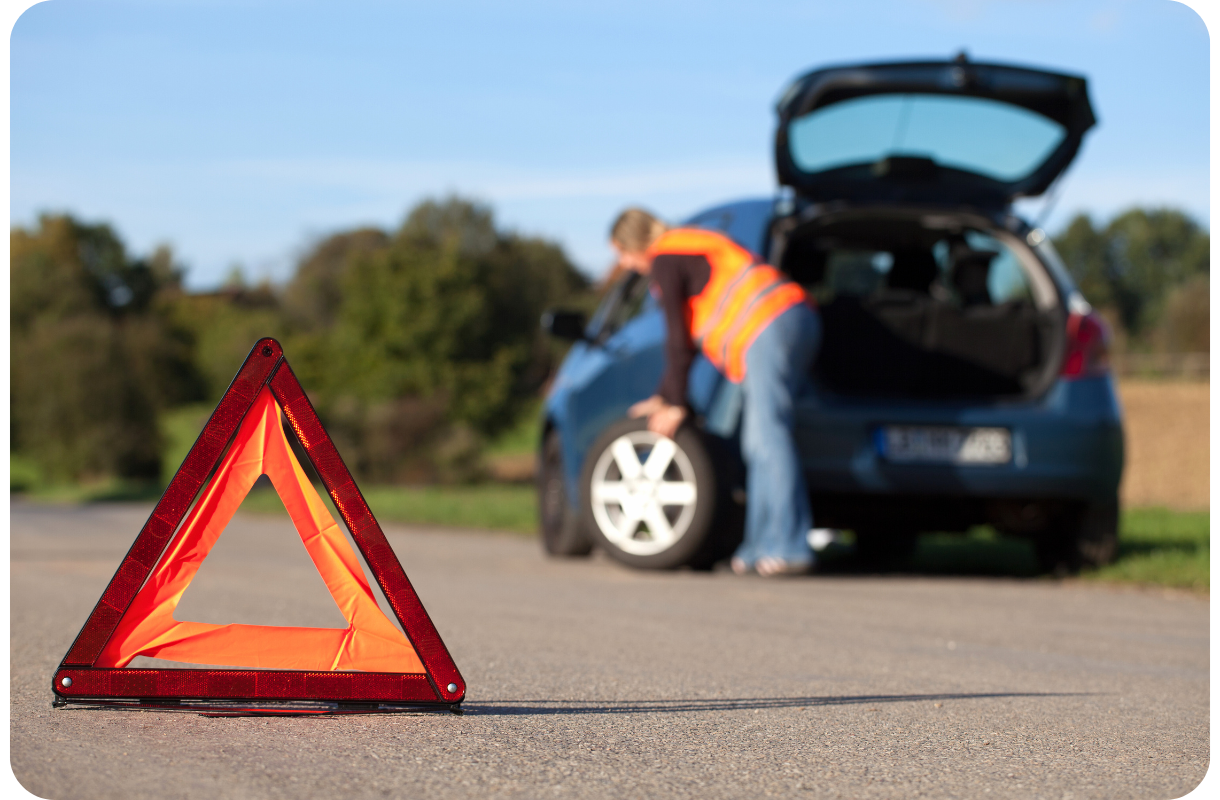.jpeg)
Explore expert insights on how to change car tires safely to drive smarter and stay informed.
Explore expert insights on how to change car tires safely to drive smarter and stay informed.
.jpeg)
Get Instant Quotes and Buy Coverage Online From Leading Providers
Flat tires don’t care about your schedule. They happen when you’re running late, when the weather’s awful, or when you’re miles from home with no exit in sight. It’s one of those problems that can flip a normal day upside down in seconds.
That’s why knowing how to change a tire on a car is essential. It’s not about becoming a mechanic. It’s about having enough confidence to deal with a flat without panicking. Even if you end up calling for help, understanding the process will keep you safer and a lot less stressed while you wait.
This practical guide for replacing a car tire will walk you through everything: the tools you need, a clear breakdown of changing a tire step-by-step, the safety tips you can’t skip, and when calling for roadside flat tire repair is the smartest move. By the end, you’ll know exactly how to change a car tire and handle one of the most common car headaches with confidence.
You won’t get far without the right equipment. Most cars come with a basic jack and lug wrench, but you’ll want to check before you actually need them. Here’s what to keep in your trunk:
If possible, add a small kneeling mat and a tire gauge. Having these items ready is crucial for confidently changing a car tire. Many drivers forget to check the spare’s age and pressure. AAA’s flat tire guide is a helpful reminder that spares can age out even if they’ve never been used.
Every excellent how to change a tire on a car guide starts with the basics. Once you’ve got the tools, you’ll feel more prepared to handle whatever the road throws at you.

Nobody plans for a flat, but it happens. Here’s how to swap it out quickly and safely with 10 easy steps.
Find level ground away from traffic. Turn on your hazard lights. If it’s dark, set up reflective triangles or flares.
Set the parking brake. Place a rock or wheel wedge behind the opposite tire so the car won’t roll.
You’ll need the spare tire, jack, and lug wrench. If you’ve got locking lug nuts, you’ll also need the key.
Use the lug wrench to turn each lug nut counterclockwise just enough to break the tension. Don’t remove them yet.
Check the manual to find the proper jack point. If you’re not sure how to use a car jack, take a moment to confirm. Put the jack on solid ground and raise the car until the flat is a few inches off the pavement.
Unscrew the lug nuts completely and keep them together. Pull the tire straight off and set it down safely.
Please align the holes, gently press the spare onto the hub, and carefully thread the lug nuts by hand.
Bring the car down until the spare touches the ground. Tighten the lug nuts in a star pattern so the wheel sits evenly.
Lower the car all the way, remove the jack, and tighten each lug nut one last time in the same star pattern.
Please return the flat tire and tools to the trunk. Check the spare’s pressure. If it’s a smaller donut, please maintain a speed under 50 mph and replace it with a full tire at your earliest convenience.
If you like quick mnemonics, remember: stop, secure, loosen, lift, swap, tighten, lower, check. That’s the entire process of changing car tires boiled down into one checklist.
Changing a tire is doable, but safety comes first. Keep these in mind:
Even if you’ve previously practiced how to change a tire on a car, stress can easily lead you to overlook small details. For more official guidance, NHTSA’s Tire Safety is worth bookmarking.
When you have a flat tire on the side of the road, it may be best to call in the pros. If you’re stuck on a narrow shoulder, in pouring rain, or without the right tools, don’t risk it. Roadside crews can change the tire, inspect the rim, and often catch problems you’d overlook.
Many extended vehicle protection plans include 24/7 roadside help. That’s one reason drivers consider coverage when their factory warranty expires. Chaiz’s marketplace for vehicle protection lets you compare vetted providers that often include roadside assistance as part of the package.
It’s also smart to call the pros if you’re far from home. Driving long distances on a temporary spare can cause new issues, like worn suspension or bent wheels. A pro can swap the tire properly and make sure your car’s safe to keep driving.
It's helpful to know how to change a tire on a car, but it's not the only thing you need to do to keep your car safe. You need to know when to replace your tires because they wear out over time. Consumer Reports says tires last about six years, but driving style, road conditions, and weather can speed up wear.
Knowing how to change a tire correctly gives you confidence and helps you make better decisions when you're under a lot of stress. To know when replacement is due, check tread depth, watch for cracks, and get a pro’s opinion if you’re not sure.
If you’ve ever wondered where to find a guide for replacing car tires, most national chains and local repair shops will not only swap tires but also balance and align them. That’s why you should get to a shop quickly after putting on a spare.

People who have experienced a flat tire at the most inconvenient time often provide the best advice. Here are a few that make life easier:
These small habits don’t take much effort, but they save time and reduce stress. They also make changing a tire step by step feel a lot less intimidating when you’re on the side of the road.
So now you know how to change a tire on a car and how to handle it without losing your cool. With the right tools and a calm approach, it’s completely manageable. If you’d rather not wrestle with lug nuts in a dangerous spot, it’s always smart to call for roadside flat tire repair.
Getting ready is the most important thing, whether you change the tire yourself or hire someone to do it. A little planning will keep you safe, and a little knowledge will keep you calm.